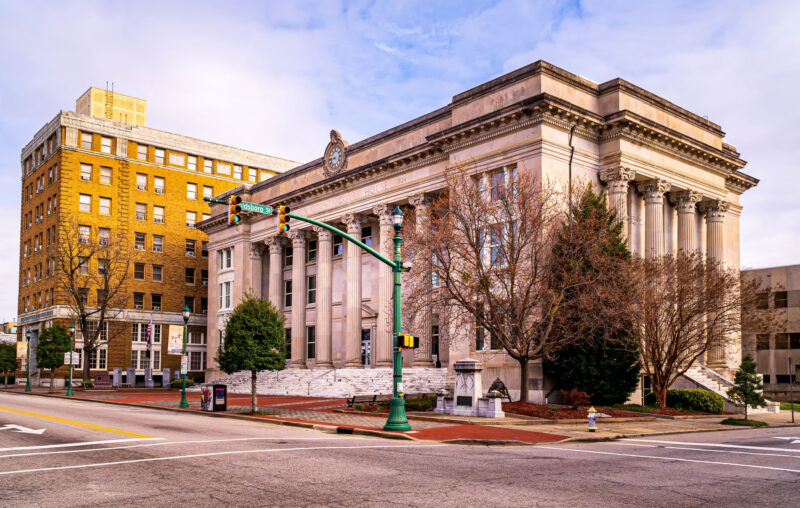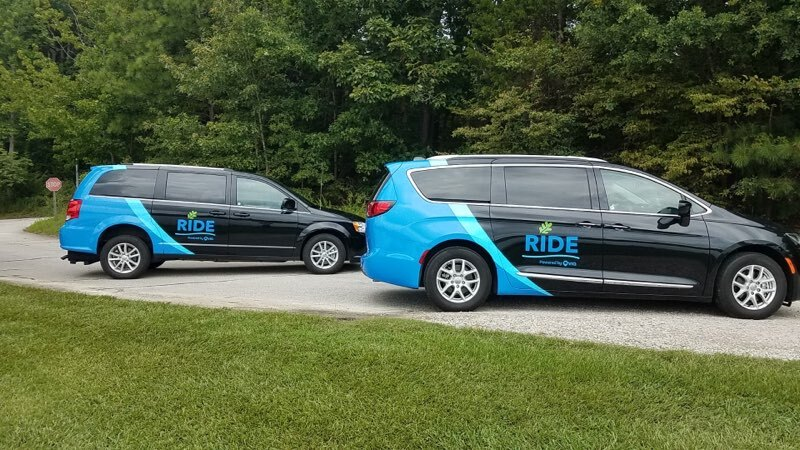


The city of Wilson, a quiet town of about 50,000 in eastern North Carolina, would not be the first place I’d look for a revolution in thinking about public transportation. Located around 40 miles east of the capital city of Raleigh, Wilson was a center of tobacco cultivation in the 1800s. Over time it evolved into a diverse, yet staid, economy that included financial services, a Bridgestone tire plant, Smithfield pork products, and smaller companies. The city’s evolution led to a population growth of 43 percent between 1980 and 2020, and like many southern cities, it grew outward rather than upward. The problem was that, as new developments on the outskirts filled with apartments and retail shops, it became increasingly harder to get to these places without a vehicle. And as in many towns, the public bus system’s limited routes made it hard to accomplish a single task in a day, let alone several.
In September of 2020, the city of Wilson embarked on a dramatic change. It eliminated its entire public bus system in one fell swoop and replaced it with an on-demand van transit system that gave residents flexible options for getting to work, school, or anywhere else in town. Working with an international company called Via, which serves communities in over 20 countries, the city implemented a system much like a shared Uber ride. Via allows residents to request a ride by phone or mobile app, walk to a nearby “virtual bus stop” and be driven to their destination.
In an interview during the launch, Wilson city manager Grant Goings noted that “our existing bus system is outdated and inconvenient for most citizens. We believe our (new system) will provide better service. According to the city, transportation issues have been the biggest hurdle to people finding and keeping employment in the city.”
This transportation hurdle faced by Wilson is a familiar challenge for many cities undergoing economic growth and development. With sprawling growth comes the increased separation between what have been called the three pillars of activity: where one lives, works, and shops. (A place to “play” is sometimes considered the fourth pillar.) Think of these pillars as hubs that each contribute to a city’s vitality and economic mobility. As the hubs grow further from each other with a city’s growth, the problem is usually solved by residents’ owning a vehicle that travels in any direction at any time. It is much harder to solve, however, with fixed-route transportation systems such as public buses, since many homes, factories, and shops invariably are located far from bus stops and routes.
Some urban planners address this by advocating for greater city density and more restrictive zoning to control urban sprawl, but this limits the freedom of those who prefer leafy suburbs, lower-priced homes, and large backyards – one of the upsides of urban sprawl. And the debate between curbing sprawl and offering more of the same doesn’t get at the heart of the issue in terms of public transportation. What’s important is a willingness to innovate, and that’s what makes the case of Wilson so remarkable. After all, we’d expect this type of courageous public transportation reform to come out of a place like Silicon Valley, not a bucolic town in eastern North Carolina.
Why doesn’t the live-work-shop transportation problem get more attention? A notable blind spot of many economists is to “assume the person owns a car,” which reminds me of the old joke about the hungry economist stranded on the desert island who decides to “assume a can opener” to open his tin of food. Even noted economist Raj Chetty, in his wide-scale studies of US economic mobility, barely touches on the issue of how people move across cities to solve the live-work-shop problem.
Yet, like everything else, developing and building pleasant suburbs has an opportunity cost. In this case, the invisible trade-off is that it becomes more difficult for those at the bottom of the economic ladder to ascend the ladder of economic mobility, if they can’t access all three pillars of city activity.
That means we need to calculate the price of the key, to fully access the economic network for a town like Wilson, or the other thousands of low-density towns and cities in the United States. According to AAA, in 2022 the cheapest car to own is a small sedan, costing about $6,350 annually, which includes fuel, maintenance, repairs, taxes, depreciation, and other fees. For people earning $15 an hour and working full-time, that works out to more than 20 percent of their annual income. That is a large expense, which is why many rely on slow and inefficient public buses.
The Center for the Study of Economic Mobility (CSEM) at Winston-Salem State University in North Carolina conducted a random survey of 215 employed bus riders in Winston-Salem in 2018, and reported findings in a CSEM working paper. We found that employees who commute to work by bus spend an average of 11 hours a week commuting, compared to 1-2 hours a week spent by car commuters. That “time tax” works out to, as one rider put it, “a part-time job for which I don’t get paid.” It saps the economy in all sorts of ways, with fewer opportunities to pursue promotions that require flexible hours, less time available for higher education or caring for families, and reduced access to healthy groceries, medical care, and more.
Typical solutions in most cities call for an increase in spending on fixed bus routes, which will never put those who cannot afford a vehicle on the same footing in terms of job opportunities and upward economic mobility. Most will be stuck in dead-end, low-paying jobs that happen to lie along a bus route. CSEM put a human face to this life with a 2018 documentary film short called “Bus Stop Jobs,” that chronicles a day in the life of an aspirational single mother named Brittany Marshall.
For the city of Wilson, the new shared-ride system has been “quite the success,” said Rodger Lentz, Via’s chief planning and development officer. Patrons wait, on average, 13 minutes for their ride, compared to an average of 45 minutes under Wilson’s former, fixed-route bus system. The Via system operates primarily during work hours, costs $2.50 a ride, and like Uber Shared Ride, picks up a small number of people along the way. Children ride free and senior citizens get discounts. Nearly 90 percent of Via’s more than 2,000 trips per week “are for essential activities, including commuting to and from work and to grocery stores, banks, and for healthcare,” the city said in a recent press release. In addition, 52 percent of the patrons of the new system say they use it to get to work. “That was one of our goals, was connecting people to employment opportunities,” Lentz said.
The system runs from 5:30 a.m. to 7 p.m., an increase from the former bus system’s hours. It costs $1.4 million annually as opposed to $1.2 million for the bus system, a 17-percent increase in the city’s budget, but the public transportation’s service area has also increased. The system now covers the entire city – and thus the entire economic system is available for all residents, regardless of whether they own a vehicle. Long term, this improved geographic mobility leads to improved economic mobility, as it gives everyone a chance to access the same hopes and dreams, with grit and determination.
Ironically, shared-ride point-to-point systems are nothing new. From 1910 to 1920, long before Uber and Via, privately owned taxis called jitneys ferried passengers throughout the city for a mere “jitney,” which was slang for a nickel. Far quicker and more comfortable than streetcars running on fixed-rail routes, they exploded into use across the United States with the invention of the Model T, and allowed lower income residents who couldn’t afford a car a way to plug into the economic network. This flexible system would have been a helpful option to keep, as our cities grew and spread. The jitneys, however, also dramatically eroded the streetcar companies’ revenues. As a result, these transportation monopolies teamed up with local city governments to drive the jitneys out of business by the early 1920s, as detailed by Eckert and Hilton in their seminal 1972 Journal of Law and Economics article.
It’s taken more than a hundred years for low-density cities to recognize that public transportation works far better in a point-to-point model, using private-public partnerships. Although Via’s innovative model involves subsidies from the city, at least those subsidies support a system that strengthens the local economy through improved economic mobility of its citizens, rather than maintaining a time-consuming and inefficient bus system. Wilson’s willingness to experiment should be a model for other cities that see fixed-route systems as the only way to ferry people across town.
Below: Wilson, North Carolina’s microtransit solution, RIDE.


TELL YOUR FRIENDS ABOUT CITIZENS JOURNAL Help keep us publishing –PLEASE DONATE




